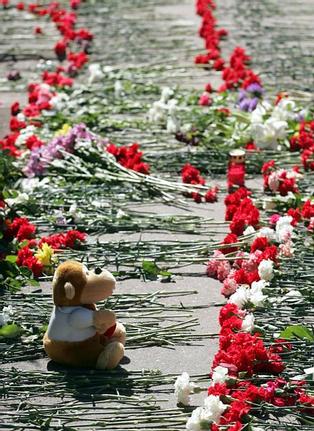
NEW REMAINS DISCOVERED IN BESLAN: INCOMPETENCE OR CRIME?
Publication: Eurasia Daily Monitor Volume: 2 Issue: 44
By:

On February 25, residents of Beslan, North Ossetia, found clothing and physical remains of several child hostages killed during the rescue operation on September 3, 2004. Jeremy Page, a reporter for the London Times, was with the residents when they made the discovery. In his words, “At first it looked like any other rubbish dump — a few clothes, some old shoes, broken tables and chairs. But when residents looked closer at the junk a mile outside their town . . . they made out clumps of hair and shreds of dried skin” (timesonline.co.uk, February 26).
Artur Boroev, a local resident, said that the people immediately realized what they had discovered when they saw a heap of children’s shoes. They also smelled the unpleasant odor of something burnt. Women started to search for the remains of their loved ones. Rita Sidakova recognized a jacket belonging to her 13-year old daughter, and Susana Dudieva found a burned wisp of hair. Dudieva said that the remains were “what dogs have not eaten yet” (yufo.ru, February 25).
The Ossetian police immediately denied knowing anything about the dumpsite that had been turned into a mass grave for dead hostages. Policemen quickly packed everything in plastic bags for “expert examination.” The local residents suspect, however, that the authorities knew of this place all along.
Murat Katsarov, who lost his daughter in the school tragedy, said that he had known about this “horrible dump.” “I found this place more then two months ago,” he said, “but I did not want to make a fuss.” Katsarov asked members of the Russian parliament’s official Investigation Commission to conduct a search of the quarry witnessed by representatives of the local authorities (yufo.ru, February 25).
Apparently, the Russian authorities had hurriedly cleaned up the crime scene after the siege ended and dumped a significant portion of the contents (timesonline.co.uk, February 26). Vladimir Khodov, head of Beslan city administration, said that this makeshift grave was not the result of malicious intent (yufo.ru, February 25). However, the Beslan residents promised to find the responsible parties and to punish them.
Dudieva, head of the Committee of Beslan Mothers and the mother of a 12-year-old boy who died in the siege, summed up the resident’s rage: “First they let those bandits kill our children and then they let dogs eat their bodies. Why didn’t they tell us about it?” The remains “should have been examined, then buried or burnt” (timesonline.co.uk, February 26). The Times held up the find as “just the latest example of the insensitivity and incompetence with which federal and local authorities handled the terrorist siege and its aftermath.”
What makes this terrible find so unspeakable is that it included not only clothes but human remains as well. The news is especially jarring to the many residents who still have not recovered the bodies of their loved ones.
The authorities have put the number of dead hostages at 338. At the same time, according to Vladimir Kolesnikov, a deputy prosecutor-general, 105 families never located relatives known to have been in the seized school (Ekho Moskvy, September 29, 2004). The Ossetian Ministry of Internal Affairs has information regarding 80 unidentified bodies and 88 individual remains, but the official number of hostages still missing is much greater –210. The fate of another 40 hostages, mostly children, is still unclear (prima-news.ru, September 20, 2004). Presumably some of them are among the remains found in the dump.
Immediately after the crisis ended, rumors spread in Beslan that some terrorists had managed to escape the siege, taking hostages with them. Once out of town, the terrorists executed the hostages somewhere in a field outside Beslan (prima-news.ru, September 20, 2004). It is difficult know exactly who would be interested in spreading such rumors, but it they may have been a cover story intended to avoid popular fury in case the mass grave was found.
The fact that only small remains were found indicates that a very strong explosive, such as bombs, killed the hostages. As all the remains looked charred, flame-throwers might have been the weapon of choice.
There is plenty of evidence already that the assault of the school started with explosions outside of the building rather than inside it (see EDM, October 18, 2004). Novaya gazeta newspaper also found out from sources in the Investigation Commission that several spent flame-throwers had been left on the roof a building across the road in front of the school (Novaya gazeta, October 7, 2004; EDM, October 13, 2004). According to the newspaper, many hostages were almost totally consumed in the fire caused by the flame-throwers. (Novaya gazeta, October 7, 2004). German Revasov, a resident of Beslan who took part in the rescue operation, told a Radio Liberty correspondent, “People were mostly killed by the burning roof that collapsed” (Radio Liberty, October 21, 2004). Revasov also remarked that the hostages had no shrapnel wounds. This was further evidence that there was no explosion inside the building. Zifa Tsirikova, a forty-year old survivor, told a correspondent from Britain’s Guardian newspaper that on September 3 the ceiling of the school started to burn and fell down . . . and this would not have happened if the explosion had been inside (yufo.ru, February 16).
According to Versia newspaper, one indication that the authorities were preparing for the assault in advance was a verbal order from Kazbek Gusov, chief physician of the emergency ward in the Vladikavkaz Central Hospital, to prepare 600 beds by the morning of September 3 (Versia, October 13, 2004). However, after Russian Special Forces completed the rescue operation, many of these 600 potential patients never made it to the hospital. Perhaps they are the ones who were found in an abandoned quarry near Beslan.




